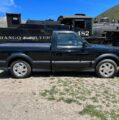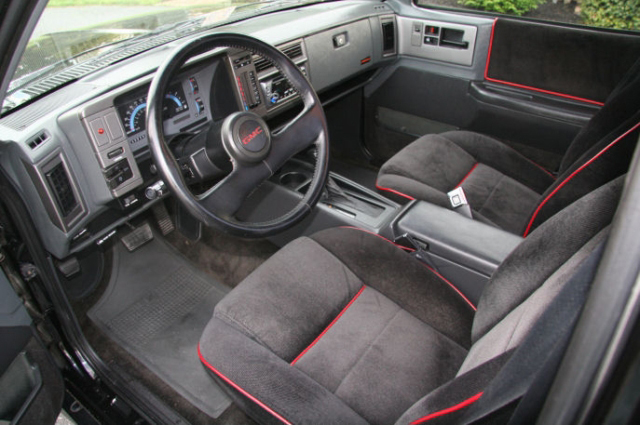During production, roughly 150 Syclones were officially converted and exported by GMC. These trucks became known as the 1991 GMC Saudi Syclone Editions. Out of the 150 trucks, there were an estimated 113 destined for for resale in the Middle East. These trucks became known as the Saudi Syclones. Externally the Saudi Syclone looks identical to its US counterpart with no apparent outward changes. The only item that appears different is when you look in the cab and notice the dash and see a different gauge cluster. Before being exported, some changes were required to be made mainly due to the leaded fuel that was used in the middle east.

The differences between the US standard production and exported Saudi Syclone are:
- Gauge cluster
- Recalibrated ECM chip with NM8 leaded fuel conversion
- High Flow Catalytic Converter
- 02 Sensor – wires were cut
GAUGE CLUSTER
The dash used is metric version of the standard GMC Sonoma/Jimmy which is normally used for vehicles destined for Canada. With a maximum registered speed of 200 km/h (124.27 mph) the dash records 4.27 mph more than the standard one and just slightly exceeds the ECM restricted vehicle speed of 124 mph.
 Saudi Syclone gauge cluster
Saudi Syclone gauge cluster
Unlike the US production Syclone gauge cluster, this cluster design is missing the RPM, Turbo Boost, and Low Turbo Coolant Warning Lamp. Other than RPM, the departure of a boost gauge can be argued as an acceptable loss. The stock boost gauge in the Syclone is commonly known to be very inaccurate and honestly….not very detailed in design leaving the driver to guess how much boost they are in. The low turbo coolant warning lamp is also a minor loss as routine checks of your coolant system can be performed.
ECM CHIP
Saudi Arabia has virtually no unleaded fuel available which meant the stock engine configuration couldn’t be exported as it came off the production line. Using leaded fuel in a production Syclone would eventually destory the catalytic convertor and oxygen sensor leading to a very rough running truck.
GM provided a solution in the form of a NM8 leaded fuel conversion. This is a radically altered chip which has all references to the oxygen (O2) sensor disabled. The MEMCAL has the NM8 EPROM with a hand written label stuck over the erase window. The meaning of the ‘6502 DOAC’ is still unknown. The lid (Bottom) to the MEMCAL has half of a luminous green sticker, again placed there with unknown reasons.
HIGH FLOW CATALYTIC CONVERTER
Catalytic convertors are damaged by lead in fuel so GM replaced the factory installed converter with a high flow version. Closer examination shows the catalytic converter has a part number of 1234567890 which is listed in the parts manual as a ‘Resonator Silencer’ and is there to provide the same level of noise reduction that a standard catalytic convertor would.
OXYGEN (O2) SENSOR
Due to the ECM NM8 Chip conversion which disabled any signal to the O2 sensor, the sensor could have either be removed altogether and the bung hole in the in the downpipe capped or just unplug the sensor. GM did neither and rather cut the wires close to the sensor so that it was virtually impossible to fix and reinstall a new connector. The wiring harness still exists for the O2 sensor so the “conversion” of the O2 sensor appears to be a rather brutal one.
Other rumored differences were:
- The seats had no Syclone embroidery – This is not the case as all the seats were the same
- The trans was calibrated to shift at 4800 Vs. 4300 RPM at WOT – In tests on Saudi vehicles it looks like the shift points are identicle to the regular Sy.
- Able to reach 156 MPH – This is not possible as the NM8 cuts boost off at 116mph and fuel shut-off is at 4714 rpm.
 The Saudi Syclone interior is the exact same as the US version aside from the gauge cluster.
The Saudi Syclone interior is the exact same as the US version aside from the gauge cluster.
EXPORTATION BACK TO THE UNITED STATES
Not all of the exported Saudi Syclones were sold immediately overseas. There were 31 trucks that remained unsold and were eventually brought back to the United States. According to an ad from an owner who appears to have worked from GM at the time:
When Desert Storm began in February 1991, the remaining 31 unsold units were moved from Riyadh to a remote desert area to escape possible damage from Scud missiles. General Motors Corporate auditors researching Manufacturers Statements of Origin (MSO’s) in 1994 realized the MSO’s were missing on these 31 units and the vehicles were unaccounted for. These units were then located and returned to GMC Divisional Headquarters in Pontiac, Michigan mid 1994.
Instead of selling the returned Saudi Syclones to the public, GMC Truck Divisional Staff sent out a letter notifying that employees would be able to purchase one of the limited number Saudi Syclones using a lotto system after they were put into company service for a period of time and able to be driven by service employees. Interested employees would submit a form and your name would be drawn to be given the opportunity to purchase a truck once the company service period had ended. It was 1 entry per employee. The sale was limited only to active GMC Truck employees at the price of $12,500 plus taxes, title, and license fees.
It was decided that since the vehicles could no longer be sold as “new” vehicles to the public, they were to be modified at the Service Lab to burn unleaded fuel and offered to GMC executive salaried employees for purchase by a lottery drawing.
The price also included a basic warranty (36 month/50,000 miles) with a $100 deductible, but excluded paint damage, transportation damage, and general deterioration from sand, sun and storage in Saudi Arabia. It is assumed paint problems were specifically not covered as the paint was supposed to not be in the best of conditions due to having been stored outside for a long period of time. A truck was kept in the executive garage that employees could view the “typical condition” of what to expect the available trucks to be in.
The winning purchasers had to agree to keep the truck for a least 12 months and counted towards a new vehicle purchase. Purchasers also had to take delivery through a dealer.
It is alleged that not many employees knew of the lottery to purchase one of the Saudi Syclones, so almost everyone who entered got the chance to buy one, which upset a lot of GM employees in various other divisions who felt they missed out.
RETURNED SAUDI SYCLONE VINS
This list includes the VINs of the trucks that were returned to the US for resale. The last four digits of the Vehicle Identification Number (VIN) for one of the 31 Saudi Syclones that came back to the US are the following:
2581, 2590, 2604, 2726, 2734, 2736, 2738, 2739, 2744, 2745, 2746, 2753, 2757, 2759, 2765, 2771, 2781, 2789, 2791, 2792, 2796, 2802, 2804, 2805, 2806, 2807, 2809, 2812, 2814, 2817, 2828
Note: Number 2590 was used as a source for replacement parts for the remaining 30 vehicles.
The remaining 69 trucks were distributed throughout Europe for sale where a small number ended up in a German compound for sometime. GMC, desperate to be rid of them, sold them on a “make us an offer” basis. Lucky purchasers managed to get ahold of one for a few thousand dollars under their market value.






 Saudi Syclone gauge cluster
Saudi Syclone gauge cluster The Saudi Syclone interior is the exact same as the US version aside from the gauge cluster.
The Saudi Syclone interior is the exact same as the US version aside from the gauge cluster.




